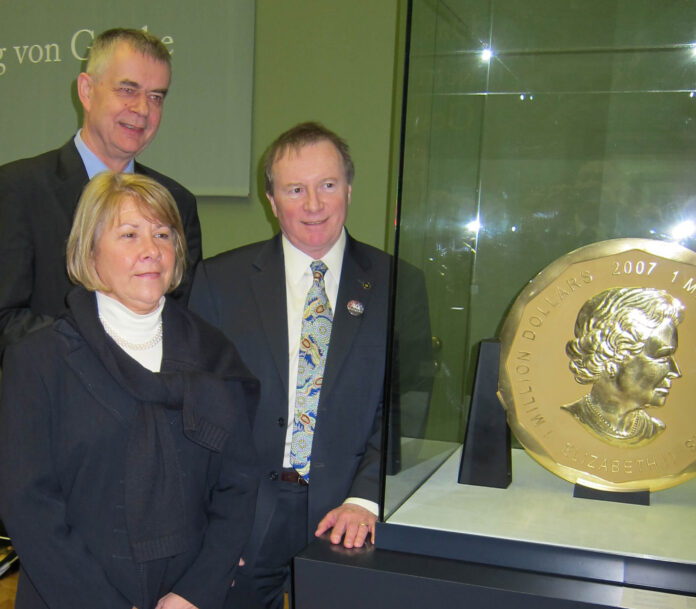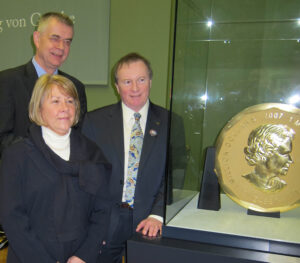
Is this how you would imagine the thieves of a 100-kilogram gold coin? In their early twenties, a high school student, a university student, a courier, a security guard of the Bode Museum. Are these young people – amateurs at first glance – capable of pulling off a coup so spectacular that the news went around the globe? It seems to be the case. However, the judiciary is of the opinion that the evidence is frighteningly thin.

Traces, Clues, Arrests
There were lots of clues after the burglary. These are the most important ones: In a Mercedes, the investigators found traces of a particularly pure gold that usually does not exist in our daily life. They stated that the number of 99.999 percent was typical for the use in the space industry – and for the Big Maple Leaf, which was worth about 3.75 million euros at the time.
The Mercedes S-Class is owned by the Remmo family, a Lebanese clan that has been known in Berlin for decades for its mafia-like activities. Three of the accused are members of this family: two brothers and their cousin. The investigators said they also identified these men on the footage of a surveillance camera. Proof that they were near the Bode Museum immediately before the theft. The three men and their alleged accomplice, a young security guard that worked at the museum, were arrested in July 2017. More than two years have passed since then. Currently, all suspects are at large.
Culprits with an Extended Family
The reason is that they are not just four young boys that – with more luck than brains – swiftly stole a 100-kilogram coin from a museum. This became evident to the trial observers at the Moabit District Court when they saw the eight top lawyers paid by the large Remmo family. And yes, apparently we can imagine the situation like those in crime thrillers and mafia movies: The legal advisers managed that their clients were freed on bail shortly after their detention, since then they have been tearing apart all the arguments of the investigating authorities. The investigators “believe” they identified the suspects on the footage. But their faces are hardly recognisable under the hoods. And the vehicle allegedly used in the crime belongs to the whole family … One thing is for sure: It is very unlikely that the four men acted at their own initiative and at their own expense, and therefore they can only be dealt with by disclosing the network of interdependencies between them and the criminal clan.

Berlin’s Fight Against Organised Crime
When the police investigated the three men in 2017, the Remmo family was targeted quickly. The investigators examined numerous properties in the context of several raids. Since then, Berlin has been committed to the fight against organised crime. Of course, it is not a crime to be a member of a certain family. First, the authorities have to develop new strategies for tackling those structures – similar to the fight against criminal rocker or terrorist groups. For the first time, the Federal Criminal Police Office (Bundeskriminalamt) dedicated a separate chapter of its report of June 2019 to clan crimes. The title is as bulky as the investigations are complex: “Kriminelle Mitglieder von Großfamilien ethnisch abgeschotteter Subkulturen” [Criminal Members of Extended Families of Ethnically Discreet Subcultures].

A Never Ending Story?
In the opinion of the leading investigator André B. and his colleagues, the pieces of evidence add up to a conclusive picture. However, the defendant’s lawyer Toralf Nöding considers the results of the investigation to be at best “general” clues. And the judge agrees with him.
In fact, monitoring the phones of numerous members of the Remmo family did not help the investigation. The police assume that they communicated mainly via messenger services since there were barely any phone calls at all. That does not sound surprising. Also non-criminals changed their communication habits.
Only one of the three suspects, Wissam Remmo, is currently under pressure. Traces of gold have been found in his jacket. And there is a connection between his sleeping place and a smartphone. The reason is that an application for the calculation of gold prices was installed on a smartphone regularly located next to the sofa Wissam Remmo slept on. Moreover, the phone revealed the trace of a Google search on the question of which freely available equipment could be used to melt down gold. An argumentation chain that can be questioned easily.
However, Wissam Remmo’s lawyer pointed out that the signal of this very smartphone was not registered by a transmitter mast near the crime scene when the theft happened but at a completely different place… Chief Officer André B. was not able to come up with a verifiable explanation for this fact…
Such pitfalls slow down the trial. There is no end in sight. And definitely no destruction of the criminal clan structures. Speaking of destruction: There is still no further information about what happened to the gold coin. There is every reason to believe that the Big Maple Leaf was melted down. So far, there is no proof about whether the Google search on the mobile phone, which was regularly placed next to the sofa Wissam Remmo slept on, played a role in it.
In January, we reported on the opening of the trial.
This Bloomberg illustration shows in comic book style how the crime was committed.
If you would like to know more about how Berlin’s Lebanese mafia clans work, take a look at this article published by Deutsche Welle. On their website you can also read about the Berlin police’s raids against organised crime.
A museum curator and another staff member operated much more perfidiously – but also with much more expertise – when they secretly stole and sold exhibits of Stockholm’s Royal Coin Cabinet.




